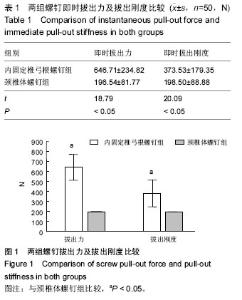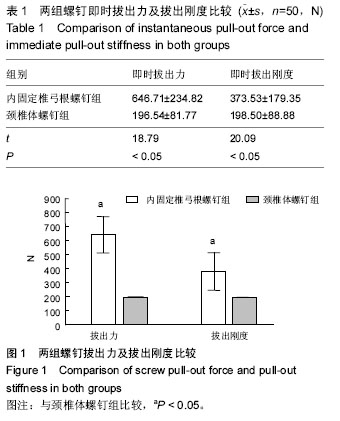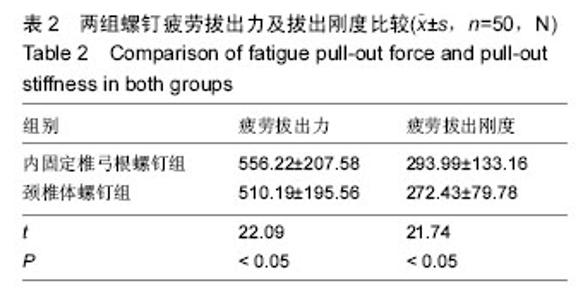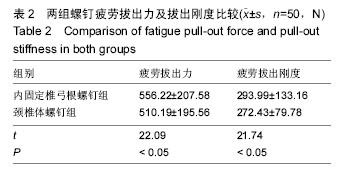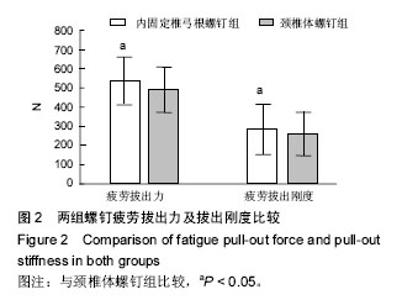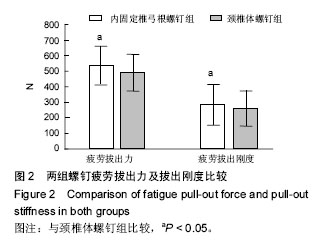Chinese Journal of Tissue Engineering Research ›› 2016, Vol. 20 ›› Issue (35): 5210-5215.doi: 10.3969/j.issn.2095-4344.2016.35.006
Previous Articles Next Articles
Biomechanics and stability of the spine after implantation with pedicle screw and cervical vertebral screw fixation
Liu Miao, Shang Xian-wen, Ning Xu, Zhuang Yong, Xu Shun-en
- Department of Orthopedics, Affiliated Hospital, Guizhou Medical University, Guiyang 550001, Guizhou Province, China
-
Revised:2016-06-19Online:2016-08-26Published:2016-08-26 -
Contact:Shang Xian-wen, Chief physician, Master’s supervisor, Department of Orthopedics, Affiliated Hospital, Guizhou Medical University, Guiyang 550001, Guizhou Province, China -
About author:Liu Miao, Master, Attending physician, Department of Orthopedics, Affiliated Hospital, Guizhou Medical University, Guiyang 550001, Guizhou Province, China
CLC Number:
Cite this article
Liu Miao, Shang Xian-wen, Ning Xu, Zhuang Yong, Xu Shun-en. Biomechanics and stability of the spine after implantation with pedicle screw and cervical vertebral screw fixation[J]. Chinese Journal of Tissue Engineering Research, 2016, 20(35): 5210-5215.
share this article
| [1] Meyer D,Meyer F,Kretschmer T,et al. anslaminar screws of the axis--an alternative technique for rigid screw fixation in upper cervical spine instability. Neurosurg Rev. 2012;35(2):255-261, discussion 261.
[2] 王洪伟,李长青,周跃,等.脊柱骨折经伤椎椎弓根置钉附加横连短节段固定的稳定性测试[J].中国脊柱脊髓杂志, 2010, 20(9):745-749.
[3] 武启军,王自立,戈朝晖,等.脊柱单节段前中柱切除后不同节段椎弓根螺钉内固定的稳定性测试[J].中国脊柱脊髓杂志,2010,20(4): 267-269.
[4] Nakashima H,Yukawa Y, Imagama S,et al. Complications of cervical pedicle screw fixation for nontraumatic lesions: a multicenter study of 84 patients. J Neurosurg Spine. 2012;16(3):238-247.
[5] 雍明,吴继功,马华松,等.万向椎弓根钉在不同矢状角下把持力的生物力学测试[J].安徽医学,2011,32(8):1110-1114.
[6] Schaefer C,Begemann P,Fuhrhop I,et al. Percutaneous instrumentation of the cervical and cervico-thoracic spine using pedicle screws: preliminary clinical results and analysis of accuracy. Eur Spine J. 2011;20(6):977-985.
[7] 庞小平,于海龙,李小龙,等.以CT三维重建技术测量颈椎椎弓根螺钉的置入参数[J].中国组织工程研究与临床康复,2010,4(9):1555-1558.
[8] Choi UY,Park JY,Kim KH,et al. Unilateral versus bilateral percutaneous pedicle screw fixation in minimally invasive transforaminal lumbar interbody fusion. Neurosurg Focus. 2013;35(2): E11.
[9] Knutsen H,Olsen EM,Jorde PE,et al. Are low but statistically significant levels of genetic differentiation in marine fishes 'biologically meaningful'? A case study of coastal Atlantic cod.Mol Ecol. 2011;20(4):768-783.
[10] 陆建华,王志刚,黄莉,等.应用数字骨科技术获取腰椎双皮质椎弓根螺钉的置入参数[J].中国组织工程研究,2012, 16(52):9732-736.
[11] 王远政,田晓滨,刘洋,等. Mimics及颈椎模型用于下颈椎椎弓根个体化置钉的应用研究[J].第三军医大学学报, 2012,34(15):543-147.
[12] Tender GC,Miller LE,Block JE.Percutaneous pedicle screw reduction and axial presacral lumbar inter- body fusion for treatment of lumbosacral spondylolisthesis: A case series. J Med Case Reports. 2011;5:454-461.
[13] 闫亮,池永龙,黄其杉,等.经皮枢椎椎弓根螺钉内固定的影像学研究[J].浙江创伤外科,2008,13(2):95-96.
[14] Kim JS,Choi WG,Lee SH.Minimally invasive anterior lumbar interbody fusion followed by percutaneous pedicle screw fixtion for isthmic spondylolisthesis: minimum 5-year follow up. Spine. 2010;10(5): 404-409.
[15] Yu W,Zhang C,Zhang B,et al.[Cytotoxicitic detection of laser welding between NiTi shape memory alloy and stainless steel in vitro].Zhonghua Kou Qiang Yi Xue Za Zhi.2014;49(4):239-243.
[16] Heravi F,Moayed MH,Mokhber N.Effect of fluoride on nickel-titanium and stainless steel orthodontic archwires: an in-vitro study.J Dent (Tehran).2015; 12(1):49-59.
[17] Ghaith el-S,Hodgson S,Sharp M. Laser surface alloying of 316L stainless steel coated with a bioactive hydroxyapatitetitanium oxide composite.J Mater Sci Mater Med. 2015;26(2):83.
[18] de Souza Melo R,Amorim da Silva PW,da Silva LV. Avalia o postural da coluna vertebral em crian as e adolescentes com deficiência auditiva/ Vertebral column posture evaluation in children and teenagers with auditive deficiency.Arquivos Int Otorrinolaringol (Impr.).2011;15(2):195-202.
[19] Puelma F,Olave E. Relaciones del Origen del Tronco Celiaco,Arterias Mesentéricas y Renales con la Columna Vertebral en Individuos Chilenos/ Relationships Between of the Origin of Celiac Trunk,Mesenteric and Renal Arteries with the Vertebral Column in Chilean Individuals. Int J Morphol.2010; 28(4):1227-1234.
[20] Olave E,Puelma F,Henríquez J.Niveles de Origen de las Arterias Renales y Mesentérica Superior Respecto a la Columna Vertebral en Individuos Chilenos: Estudio por Tomografía Computarizada Helicoidal. Int J Morphol.2009; 27(2):447-452.
[21] 侯金健,高强强,安晓婷.国内外高温钛合金研究及应用的最新发展[J].热加工工艺,2014,43(10):11-15.
[22] 朱丽丽.羟基磷灰石涂层钛合金材料生物相容性研究初探[J].生物医学工程与临床,2014,18(4):323-326.
[23] Filli L,Luechinger R,Frauenfelder T,et al.Metal-induced artifacts in computed tomography and magnetic resonance imaging: comparison of a biodegradable magnesium alloy versus titanium and stainless steel controls.Skeletal Radiol. 2015;44(6):849-856.
[24] Kaku N,Tabata T,Tsumura H. Mechanical evaluation of hip cement spacer reinforcement with stainless steel Kirschner wires, titanium and carbon rods, and stainless steel mesh.Eur J Orthop Surg Traumatol. 2015;25(3):489-496.
[25] 蔡志群,马琪峰.一期前路病灶清除钛网置入治疗胸腰椎结核[J].按摩与康复医学(下旬刊),2010,1(4):101-102.
[26] Jeromel M,Podobnik J.Magnetic resonance spectroscopy (MRS) of vertebral column-an additional tool for evaluation of aggressiveness of vertebral haemangioma like lesion.Radiol Oncol.2014,48(2): 137-141.
[27] 邓强,郭海龙,盛伟斌,等.钉棒系统置入内固定结合病灶清除治疗老年胸腰骶椎结核[J].中国组织工程研究,2013, 17(13):2463-2470.
[28] 郭新军,朱振军.人工珊瑚骨内固定手术治疗脊柱结核的临床效果分析[J].现代预防医学,2012,39(10):2628-2629, 2631.
[29] 王文胜.一期前路病灶清除、钛网融合器置入内固定术治疗脊柱结核[J].中国医学创新,2010,7(36):41-42.
[30] 张小飞,施红光,赵剑,等.脊柱结核内固定的生物学基础[J].实用骨科杂志,2012,18(4): 321-322.
[31] 羊明智,彭立军,胡文凯,等.一期前路病灶清除植骨选择性病椎内固定术治疗胸腰椎结核疗效观察[J].山东医药, 2013, 53(31):40-42.
[32] 陈世忠.椎间融合器与单纯椎间植骨法治疗退变性腰椎滑脱症的疗效分析[J].中国骨与关节损伤杂志,2010, 25(5):439-440.
[33] 邓必权,胡华,滕宇,等.椎弓根螺钉复位内固定后单纯植骨融合与椎间融合器融合治疗腰椎滑脱症的疗效比较[J].中国老年学杂志,2015,35(7):1823-1825.
[34] 韩建华,孙厚杰,周鑫,等.腰椎退行性滑脱症内固定与不同植骨融合方式的疗效比较[J].中国矫形外科杂志,2014, 22(13): 1226-1230.
[35] 周连军.后路椎弓根内固定结合椎间融合器与单纯椎间植骨融合治疗腰椎不稳的疗效比较[J].实用临床医药杂志,2014,18(13): 79-80,85.
[36] Doulgeris JJ,Aghayev K,Gonzalez-Blohm SA,et al. Biomechanical comparison of an interspinous fusion device and bilateral pedicle screw system as additional fixation for lateral lumbar interbody fusion.Clin Biomech (Bristol, Avon). 2015;30(2):205-210.
[37] Villavicencio AT,Serxner BJ,Mason A,et al.Unilateral and bilateral pedicle screw fixation in transforaminal lumbar interbody fusion: radiographic and clinical analysis.World Neurosurg.2015;83(4):553-559.
[38] Xiao SW,Jiang H,Yang LJ,et al.Comparison of unilateral versus bilateral pedicle screw fixation with cage fusion in degenerative lumbar diseases: a meta-analysis.Eur Spine J.2015;24(4):764-774.
[39] 谢光艳.椎弓根螺钉内固定联合椎体间植骨融合治疗退行性腰椎滑脱临床疗效分析[J].医学信息,2015,29(12): 168-169.
[40] Yang X,Wang H,Zhao Q,et al.A comparison of unilateral and bilateral pedicle screw fixation combined with transforaminal lumbar interbody fusion for lumbar degenerative diseases. Chin Med J (Engl).2014; 127(20): 3592-3596. |
| [1] | Shi Bin, An Jing, Chen Long-gang, Zhang Nan, Tian Ye . Influencing factors for pain after total knee arthroplasty [J]. Chinese Journal of Tissue Engineering Research, 2017, 21(7): 993-997. |
| [2] | Wang Xian-xun. Impact of local compression cryotherapy combined with continuous passive motion on the early functional recovery after total knee arthroplasty [J]. Chinese Journal of Tissue Engineering Research, 2017, 21(7): 998-1003. |
| [3] | Yuan Wei, Zhao Hui, Ding Zhe-ru, Wu Yu-li, Wu Hai-shan, Qian Qi-rong. Association between psychological resilience and acute mental disorders after total knee arthroplasty [J]. Chinese Journal of Tissue Engineering Research, 2017, 21(7): 1015-1019. |
| [4] | Chen Qun-qun, Qiao Rong-qin, Duan Rui-qi, Hu Nian-hong, Li Zhao, Shao Min. Acu-Loc®2 volar distal radius bone plate system for repairing type C fracture of distal radius [J]. Chinese Journal of Tissue Engineering Research, 2017, 21(7): 1025-1030. |
| [5] | Huang Xiang-wang, Liu Hong-zhe. A new low elastic modulus of beta titanium alloy Ti2448 spinal pedicle screw fixation affects thoracic stability: biomechanical analysis [J]. Chinese Journal of Tissue Engineering Research, 2017, 21(7): 1031-1035. |
| [6] | Xie Qiang. Three-dimensional finite element model for biomechanical analysis of stress in knee inversion and external rotation after posterior cruciate ligament rupture [J]. Chinese Journal of Tissue Engineering Research, 2017, 21(7): 1036-1040. |
| [7] | He Ze-dong, Zhao Jing, Chen Liang-yu, Li Ke, Weng Jie. Multilevel finite element analysis on the biological tribology damage of water on bone tissue [J]. Chinese Journal of Tissue Engineering Research, 2017, 21(7): 1041-1045. |
| [8] | Jiang Zi-wei, Huang Feng, Cheng Si-yuan, Zheng Xiao-hui, Sun Shi-dong, Zhao Jing-tao, Cong Hai-chen,Sun Han-qiao, Dong Hang. Design and finite element analysis of digital splint [J]. Chinese Journal of Tissue Engineering Research, 2017, 21(7): 1052-1056. |
| [9] | Wang Fei, Liu Zhi-bin, Tao Hui-ren, Zhang Jian-hua, Li Chang-hong, Cao Qiang, Zheng Jun, Liu Yan-xiong, Qu Xiao-peng. Clinical efficacy of preoperative osteotomy designs using paper-cut technology versus photoshop software for ankylosing spondylitis with kyphosis [J]. Chinese Journal of Tissue Engineering Research, 2017, 21(7): 1057-1063. |
| [10] | Li Hui, Ma Jun-yi, Ma Yuan, Zhu Xu . Establishment of a three-dimensional finite element model of ankylosing spondylitis kyphosis [J]. Chinese Journal of Tissue Engineering Research, 2017, 21(7): 1069-1073. |
| [11] | Ling Guan-han, Ou Zhi-xue, Yao Lan, Wen Li-chun, Wang Guo-xiang, Lin Heng-feng. Establishment of simulating three-dimensional model of China-Japan Friendship Hospital Classification for L type osteonecrosis of the femoral head [J]. Chinese Journal of Tissue Engineering Research, 2017, 21(7): 1074-1079. |
| [12] | Fu Wei-min, Wang Ben-jie. Assessing the degree of necrotic femoral head, and association of blood supply with pathlogical changes: study protocol for a diagnostic animal trial [J]. Chinese Journal of Tissue Engineering Research, 2017, 21(7): 1086-1091. |
| [13] | Zhang Wen-qiang, Ding Qian, Zhang Na. Associations between alpha angle and herniation pit on oblique axial magnetic resonance imaging in asymptomatic hip joints of adults [J]. Chinese Journal of Tissue Engineering Research, 2017, 21(7): 1098-1103. |
| [14] | Sun Xiao-xin1, Zhou Wei2, Zuo Shu-ping3, Liu Hao1, Song Jing-feng1, Liang Chun-yu1. Morphological characteristics for the magnetic resonance imaging assessment of discoid lateral meniscal tears in children [J]. Chinese Journal of Tissue Engineering Research, 2017, 21(7): 1104-1109. |
| [15] | Lin Han-wen, Wen Jun-mao, Huang Chao-yuan, Zhou Chi, Tang Hong-yu. Correlation between the changes in lower limb power line and pain area in the knee osteoarthritis patients: imaging evaluation [J]. Chinese Journal of Tissue Engineering Research, 2017, 21(7): 1110-1114. |
| Viewed | ||||||
|
Full text |
|
|||||
|
Abstract |
|
|||||
